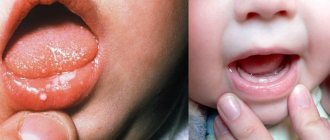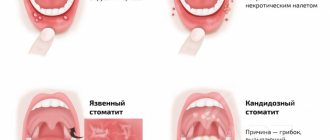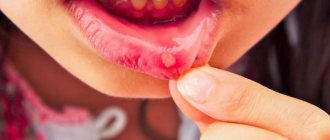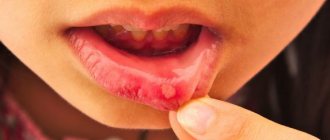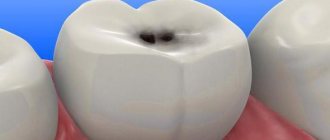Causes of thrush in a child’s mouth
The disease can appear in infants literally from birth - in the first week of life. Its causative agent is the yeast-like fungus Candida. This fungus lives in the body constantly and, with good immunity, does not cause any harm, but when some disruptions occur, the disease develops, and then treatment for candidal stomatitis in children cannot be avoided.
The disease can be caused by:
- vaginal candidiasis of the mother (the child becomes infected with the fungus while passing through the birth canal);
- long-term use of antibiotics;
- the presence of any diseases, for example, ARVI;
- teething;
- improper oral hygiene of the baby or lack thereof.
Regardless of the causes of formation, treatment of thrush in newborns should be carried out under the supervision of a medical specialist.
Candidal stomatitis (thrush)
Treatment of candidal stomatitis includes eliminating the cause of the disease, providing a balanced diet, stimulating the immune system and improving oral hygiene. These measures may be enough to cure stomatitis in adults and children. To treat thrush in newborns, the oral cavity should be treated with the following drugs: soda solution, iodinol, 1% aniline dyes.
For moderate and severe cases, the treatment of candidal stomatitis includes oral medications, as well as antifungal ointments. Antifungal drugs are used internally to treat thrush, which are prescribed by the attending physician, taking into account the patient’s age. Treatment is continued until the symptoms of thrush in the oral cavity are completely eliminated, so that there are no relapses.
The course of treatment and type of medications depends on the health of your child, as well as the form of the disease.
Infants are almost always treated with topical antifungal medications. This type of medication is not used to treat adults because their mouths are larger and it is difficult to apply the medication to all affected areas.
Mild form of candidal stomatitis Treatment of mild forms of candidal stomatitis in adults occurs at home and does not present any difficulty. Treatment of the disease involves the use of antifungal elixirs and lozenges. The course of treatment usually lasts no more than two weeks.
A mild form of candidal stomatitis in infants is treated with external medications for at least two days after the symptoms disappear.
Moderate to severe candidal stomatitis More severe forms of the infection that have entered the esophagus are treated with oral antifungal medications. External use of similar drugs is also possible.
In severe cases of the disease, the course of treatment lasts more than two weeks.
Oral antifungal drugs are almost never used to treat pregnant women because of the potential for harm to the baby. But in very rare cases, namely in severe cases of the disease, such drugs can be used for treatment, since the infection can enter the blood. In this case, mother and child are at great risk.
Persistent and recurrent form of candidal stomatitis Persistent and recurrent form of candidal stomatitis require: • Twice as much treatment time until symptoms disappear. • Treatment with both oral and topical antifungal medications.
People with weakened immune systems can take antifungal medications on an ongoing basis to prevent thrush.
It is very important to eliminate all sources of infection, as the disease may return.
To prevent this, thoroughly disinfect toys, pacifiers, bottles and other items that the child puts in his mouth or may give to another baby. For more detailed information, read the relevant section on preventing thrush.
Diseases such as diabetes and HIV (immunodeficiency virus) increase the chances of developing thrush.
If the child has a mild form of this disease, then you just need to thoroughly wash bottles and pacifiers, and also regularly wipe the child’s mouth with a damp cloth. If you are breastfeeding, you should treat your nipples with an antifungal medication, such as nystatin (mycostatin). After feeding, dry your breasts and apply lanolin to relieve soreness.
If you wear dentures and your doctor has diagnosed you with candidal stomatitis, you need to remove them daily, wash your dentures every evening and wipe your mouth. • Remove dentures before bed. • Rinse them thoroughly using a clean toothbrush and water. • Leave them overnight in chrogexidine gluconate solution, which can be purchased at the pharmacy. An alternative is a dental and oral cleanser (Polident or Efferdent). • Rinse your dentures thoroughly in the morning. If you soaked them in a solution of chrogexidine gluconate, you should not use fluoride-containing toothpaste for 30 minutes after putting the dentures back (fluoride weakens the effect of chrogexidine gluconate).
Sometimes, for candidal stomatitis, a 1% solution of gentian violet is used, a dye that kills bacteria and is an antifungal agent. This substance can only be used by adults, so you should consult your doctor if you are going to use it on your child. If gentian violet is ineffective, the attending physician will prescribe another remedy.
Do not despair! If thrush causes discomfort, try the following tips: • Drink cold drinks, such as water, iced tea, or frozen juices. • eat soft foods that are easy to swallow, such as ice cream or sweet cream; • if the white coating causes pain, drink from a straw; • rinse your mouth several times a day with warm water (1 teaspoon of salt per glass of water).
Symptoms of stomatitis in newborns
As a rule, candidal stomatitis in children begins asymptomatically, so the child does not show concern. As the disease progresses, his behavior changes - the baby refuses to eat and becomes capricious. Due to the active proliferation of the fungus, the taste of food changes, which may explain the lack of appetite.
Pronounced signs that treatment of candidal stomatitis is required in children are:
- a whitish, cheesy coating in the oral cavity - it is especially clearly visible in the morning, after waking up;
- sour breath;
- swelling and redness of the gums.
Candidal stomatitis in children has three degrees of severity. In mild and moderate forms of the disease, the white coating is easily removed, but at the same time areas of bright red mucous membranes are exposed. In severe form, the plaque is already denser. And since it is fused to the mucous membrane, it is quite difficult to remove. And if this succeeds, an eroded mucous membrane with bruises opens. Thrush in a baby’s mouth is usually clearly visible in the early stages, so prompt consultation with a doctor can prevent the development of complications.
Treatment of candidal stomatitis in children must be started in a timely manner, otherwise complications in the form of a secondary infection and the gradual spread of the fungus throughout the child’s body cannot be avoided.
Candidal stomatitis can be identified by the symptoms in the following photos:
Types and forms of pathology
In practice, acute and chronic oral candidiasis occurs. The first develops rapidly, the second is characterized by a sluggish course and vague symptoms, periodic relapses and inflammation.
Acute fungal candidal stomatitis can be pseudomembranous (white plaque is easily removed and reveals reddened areas) and atrophic (there is no plaque, the mucosal surface dries, turns red and becomes painful).
Chronic thrush can be hyperplastic (white or grayish cheesy plaques form on the soft tissues) and atrophic (the oral mucosa dries out, becomes thinner, the patient complains of pain and discomfort).
Clinical treatment
The success of treatment of candidal stomatitis in children can only be said if all sources of infection have been completely eliminated. When the cause of oral disease is the use of antibiotics, in parallel with general treatment, a course of antifungal therapy may be prescribed.
The principle of treating candidal stomatitis in children comes down to creating an alkaline environment in the oral cavity - it is this pH value that is detrimental to fungi. In addition, in an alkaline environment, most pathological microorganisms die, including those that cause carious tooth decay.
The child’s oral cavity can be treated with a solution of baking soda (the optimal concentration will be determined by the attending physician). The procedure for treating candidal stomatitis in children is quite simple: a gauze swab soaked in a solution is used to treat the oral mucosa of the gums and cheeks.
In severe cases, your dentist may prescribe oral medications.
The Doka-Dent dental clinic provides quick and safe diagnostics for effective treatment of stomatitis in infants and older children. Branches in Moscow are located at two addresses:
- Teply Stan district, Leninsky Prospekt, building 131, 1st and 2nd floor. One minute from Troparevo metro station in a building located between Leninsky Prospekt and Academician Bakulev Street.
- Tverskoy district, 1st Tverskaya-Yamskaya, building 27, 2nd floor. Three minutes from any exit from Belorusskaya station in a building located between the first Tverskaya-Yamskaya and the first Brestskaya streets.
Specialists from both clinics conduct examinations free of charge and help urgently prevent the development of complications and the spread of the disease!
Signs and treatment of viral stomatitis
In order to correctly prescribe treatment, it is necessary to determine the cause of the inflammatory process.
The most contagious types of thrush or stomatitis in children are of fungal, viral, bacterial etiology; they most often affect children from birth to two years.
How is stomatitis different from thrush? Stomatitis can also be caused by influenza, chickenpox, herpes, enteroviruses and adenoviruses. Almost 90% of the population are carriers of the herpes virus , and the disease develops only in people with weakened immune systems. Herpetic stomatitis is most often diagnosed in children.
It causes the following symptoms:
- the appearance of swelling and redness;
- the appearance of small bubbles (vesicles);
- body temperature up to 40 °C;
- subsequently the vesicles burst and liquid flows out of them;
- formation of ulcers and erosions in the mouth;
- Huge discomfort in babies, which is caused by burning, dryness, and pain.
In complex forms of herpetic stomatitis, nausea, vomiting, fever or headache may occur. Up to 20 vesicles may appear in the mouth.
In mild cases, the temperature remains at the subfebrile level and the blisters are slightly, no more than 6. For treatment, antiviral drugs with interferon, oxolinic ointment and Cholisal gel are used.
Gel Cholisal
For high temperatures, antipyretics are used, and for itching and burning, antihistamines are used in the form of drops for children under 5-6 years of age, and in the form of tablets for children older than this age. We also monitor personal hygiene and control nutrition.
